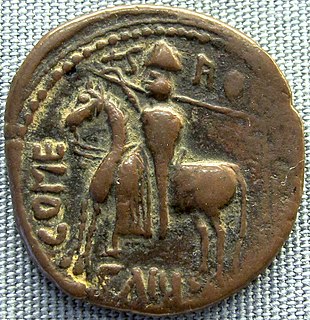
Who Framed Roger Rabbit is a 1988 American live-action/animated comedy film directed by Robert Zemeckis, produced by Frank Marshall and Robert Watts, and written by Jeffrey Price and Peter S. Seaman. The film is based on Gary K. Wolf's 1981 novel Who Censored Roger Rabbit?. The film stars Bob Hoskins, Christopher Lloyd, Charles Fleischer, Stubby Kaye, and Joanna Cassidy. Combining live-action and animation, the film is set in Hollywood during the late 1940s, where cartoon characters and people co-exist. The story follows Eddie Valiant, a private detective who must exonerate "Toon" Roger Rabbit, who is accused of murdering a wealthy businessman.

Roger II was King of Sicily, son of Roger I of Sicily and successor to his brother Simon. He began his rule as Count of Sicily in 1105, became Duke of Apulia and Calabria in 1127, and then King of Sicily in 1130. By the time of his death at the age of 58, Roger had succeeded in uniting all the Norman conquests in Italy into one kingdom with a strong centralized government.

Roger I, nicknamed Roger Bosso and The Great Count, was a Norman nobleman who became the first Count of Sicily from 1071 to 1101. He was a member of the House of Hauteville, and his descendants in the male line continued to rule Sicily down to 1194.

Doris Angleton was a Texas socialite and murder victim. Doris Angleton's husband, Robert Angleton, had been accused of planning the crime. Roger Nicholas Angleton, Robert Angleton's brother, admitted to directly killing his sister-in-law and exonerated his brother before killing himself.
Robert de Bellême, seigneur de Bellême, seigneur de Montgomery, viscount of the Hiémois, 3rd Earl of Shrewsbury and Count of Ponthieu, was an Anglo-Norman nobleman, and one of the most prominent figures in the competition for the succession to England and Normandy between the sons of William the Conqueror. He was a member of the powerful House of Bellême.
This is a list of counts and dukes of Maine, with their capital at Le Mans. In the thirteenth century it was annexed by France to the royal domain.

Vladislaus I was Duke of Bohemia from 1109 to 1117 and from 1120 until his death.

Roger Clinton Jr. is an American actor and musician. He is the younger half-brother of former United States President Bill Clinton.
The Castle of Dinerth is a Welsh castle located near Aberarth, Ceredigion, west Wales that was completed c. AD 1110. It is also known as Hero Castle, presumably from the Norse hiro.
The double County of Jaffa and Ascalon was one of the four major seigneuries comprising the major crusader state, the Kingdom of Jerusalem, according to 13th-century commentator John of Ibelin.
Iorwerth ap Bleddyn (1053–1111) was a prince of Powys in eastern Wales.
Ranulf II was the count of Alife and Caiazzo, and duke of Apulia. He was a member of the Italo-Norman Drengot family which dominated the Principality of Capua for most of the century between 1050 and 1150. Ranulf's wife, Matilda, was the sister of King Roger II of Sicily.
Robert I of Bassunvilla was a Norman baron from Molise. His family originated in Vassonville, near Dieppe.

The Hauteville was a Norman family originally of seigneurial rank from the Cotentin. The Hautevilles rose to prominence through their part in the Norman conquest of southern Italy. By 1130, one of their number, Roger II, was made the first King of Sicily. His male-line descendants ruled Sicily until 1194. Some Italian Hautevilles took part in the First Crusade and the founding of the Principality of Antioch (1098).

The Norman conquest of southern Italy lasted from 999 to 1139, involving many battles and independent conquerors. In 1130 these territories in southern Italy united as the Kingdom of Sicily, which included the island of Sicily, the southern third of the Italian Peninsula, the archipelago of Malta and parts of North Africa.
Events from the 1110s in England.

The County of Sicily, also known as County of Sicily and Calabria, was a Norman state comprising the islands of Sicily and Malta and part of Calabria from 1071 until 1130. The county began to form during the Christian reconquest of Sicily (1061–91) from the Muslim Emirate, established by conquest in 965. The county is thus a transitional period in the history of Sicily. After the Muslims had been defeated and either forced out or incorporated into the Norman military, a further period of transition took place for the county and the Sicilians.
Roger d'Ivry or d'Ivri or Rog'ive or Roger Perceval was an 11th-century nobleman from Ivry-la-Bataille in Normandy. He was the younger son of Robert de Breval and his wife, Albreda, daughter of Rodolph, Lord of Ivry.
Richard of Hauteville was a noble knight of Hauteville family, the conquerors of South Italy during the 11th century.












